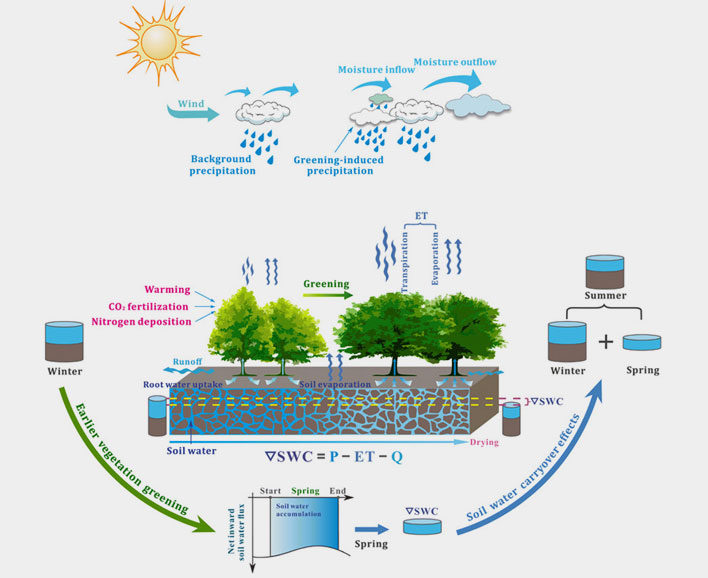Greener springs are causing drier summers in the Northern Hemisphere
Satellites are showing that as carbon dioxide (CO2) increases in the atmosphere, plants across Northern Hemisphere are responding by advancing leaf unfolding and enhancing greenness in spring.
Simultaneous weather station measurements across the area imply that summer droughts and heatwaves are becoming more frequent and longer-lasting. Although these two phenomena occur in different seasons, the latest evidence shows that there are connections between them.
A team of researchers from Peking University, China, collaborated with others from Germany, UK, Spain, Belgium, France, Australia and the USA, found that earlier spring greening causes a large water loss from land soils by evaporation. This loss raises the risk of soil moisture droughts and heat extremes in the following summer months, according to the latest study published in the journal Science Advances.
The researchers discovered this connection between seasons by statistical methods, linking satellite images of rising spring greenness with those of decreasing summer soil moisture. They additionally verify that this linkage can be replicated in computer models designed to simulate the climate system.
“How earlier greening influences soil moisture is actually more complex than previously thought. Earlier greening causes faster water losses by pumping more water into the atmosphere. However, the ‘lost water’ does not disappear, part of this subsequently returns as precipitation over land. We demonstrate that this process alleviates the greening-enhanced water losses, otherwise the surface drying would be much worse. The rest of the ‘lost water’ does not return as precipitation because the atmosphere transports it to different geographical locations”, said Xu Lian from Peking University, who is the lead author of this study.
Co-author Professor Buermann, from the Institute of Geography at Augsburg University, Germany, said that “This research addresses one of the major challenges for climate research which is to quantify the contribution of biosphere-atmosphere interactions to the extreme weather events presently occurring, such as the Northern Latitude droughts for 2018. The inter-seasonal processes found in our study can partly account for ongoing extremes, and can be expected to place additional pressure on summer soil moisture and terrestrial ecosystems under continuing climate change”.
“Hydrological trade-offs, such as earlier spring greening vs. potentially increased summer browning, represent another example of the complex and often unexpected ways climate change interacts with ecosystems”, added Alan Knapp, a professor of ecology from Colorado State University who is not involved in this study, “This analysis provides novel insight in this regard and importantly suggests new research paths for understanding how climate change can impact the ecosystems we depend on”.
Professor Josep Peñuelas from the National Research Council of Spain, added that “This research reveals an often-overlooked positive feedback: rising greenhouse gas concentrations and the associated warming causes earlier vegetation phenology that reduces summer soil moisture, and this in turn adds to summer heat extremes caused directly by global warming”.
The identified effect of “greener springs cause drier summers”, according to the study, does not hold everywhere. One exception is agricultural areas, where the intensive irrigation overrides the greening-induced signals. Another prominent exception is central Siberia, where vegetation is greening earlier yet soils are getting wetter in summer. This additional soil moisture is likely carried by atmospheric circulation from Europe, gained from the higher greening-induced evaporation rates occurring there.
“This is a fascinating Earth system teleconnection, triggered by human adjustment of the climate and related impacts on terrestrial ecosystems” said Dr Tim R. McVicar from the Commonwealth Scientific and Industrial Research Organisation (CSIRO), Australia.
“This research adds to the growing body of evidence that climate change will not occur simply as everything being the same, except for raised background temperatures. Instead, climate change will trigger highly complex interactions within the planetary system, which may locally cause some substantial changes”, added Chris Huntingford from the Center for Ecology and Hydrology, UK.









